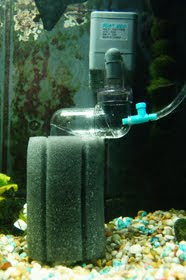Sponge Filter; Bowl or Small Aquarium Filters
 This is a very simple idea where by one uses a Hydro Sponge #2, then one would cut this filter's sponge in half, then remove the male strainer, then finally replace the sponge with this new "1/2" sponge "Mini Hydro Sponge Filter" well suited for a small aquarium (under 2 gallons) or a bowl.
This is a very simple idea where by one uses a Hydro Sponge #2, then one would cut this filter's sponge in half, then remove the male strainer, then finally replace the sponge with this new "1/2" sponge "Mini Hydro Sponge Filter" well suited for a small aquarium (under 2 gallons) or a bowl.The result of this VERY simple DIY Mini filter is an extra sponge for a future change, but just as importantly and unlike other DIY sponge filter ideas circulating here on the internet is you also still have a Quality, Patented Hydro Sponge Filter with higher bio filtration capacity per square inch (or square centimeter) and a sponge (plus spare) that does not degrade quickly.
It is also noteworthy that this Mini Aquarium or Bowl Sponge Filter is vastly superior to one of those small round under gravel filters many will use in a bowl for these reasons (especially for Betta Bowls/Containers since food often falls to the bottom where the Betta will rarely go):
*More easily rinsed (de-chlorinated tap or bowl/aquarium water should be used for rinsing, not tap water)
*Higher Bio Capacity (more space for aerobic nitrifying bacteria)
*Better oxygenation of this bio bacteria
*Much less decomposition in the substrate or bowl bottom that can result in Aeromonas bacterial outbreaks or Saprolegnia (fungus) outbreaks.
Please click on the picture above to enlarge for a better view
Labels: Aquarium sponge Filter, Betta Filter, Bowl Filter, Bowl Sponge Filter, Hydro Sponge 2, Sponge Filter, Sponge Filters







 POND SPONGE FILTERS
POND SPONGE FILTERS FILTER MAX SPONGE PRE-FILTER
FILTER MAX SPONGE PRE-FILTER Rio Internal Filter
Rio Internal Filter EVERYTHING AQUATIC
EVERYTHING AQUATIC